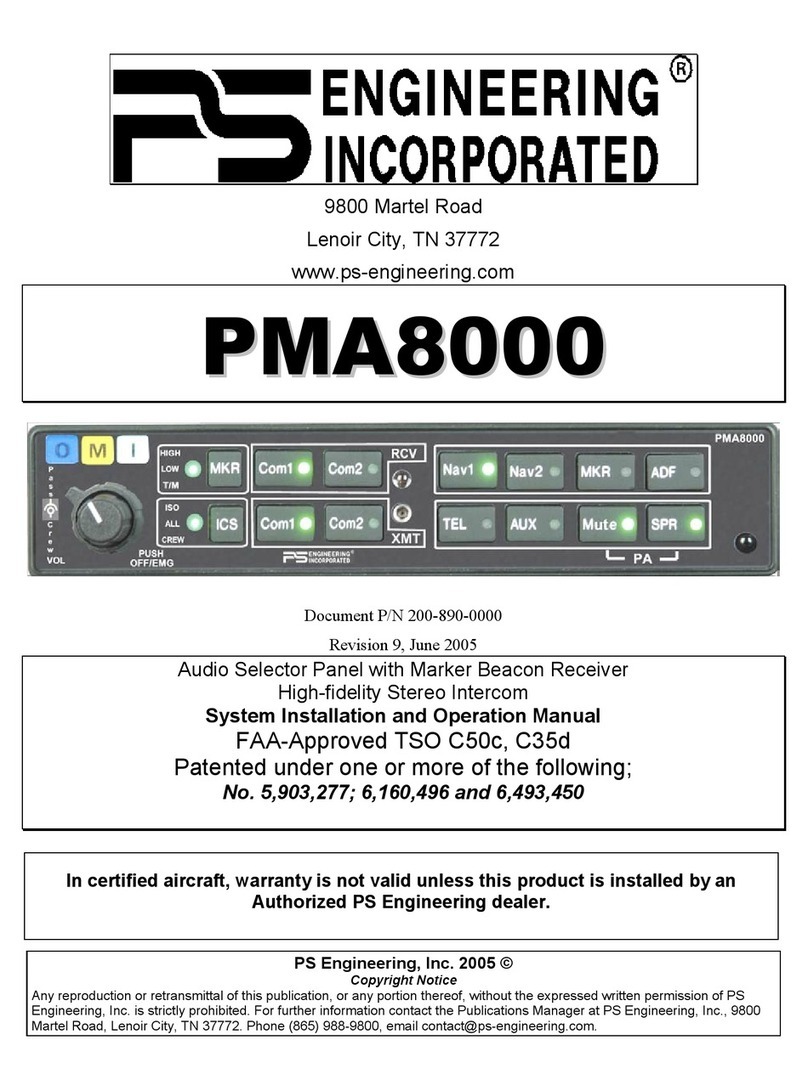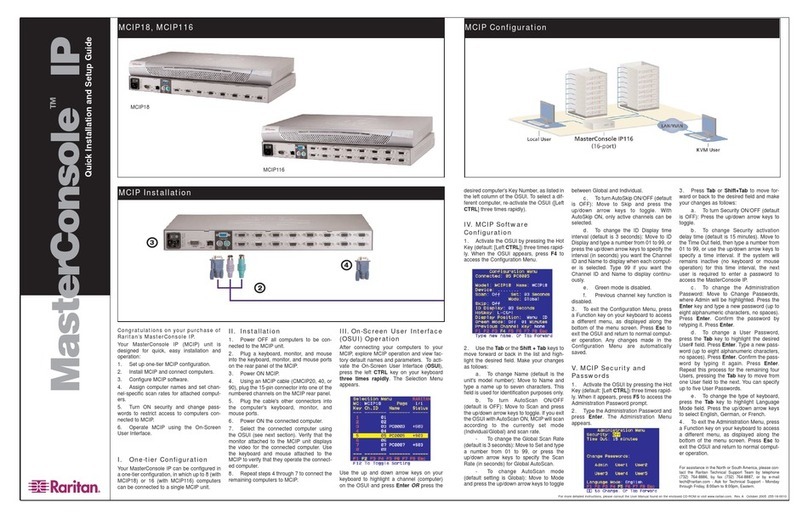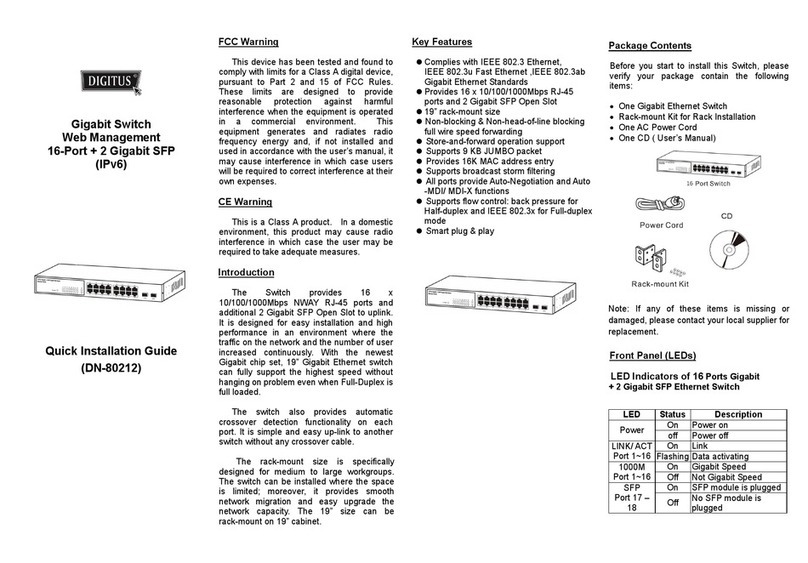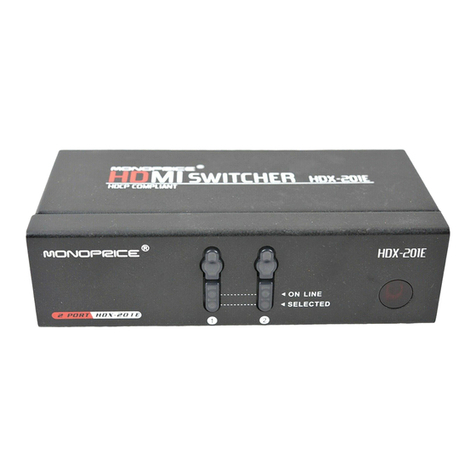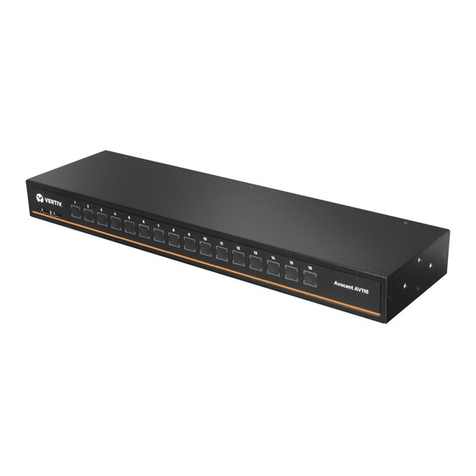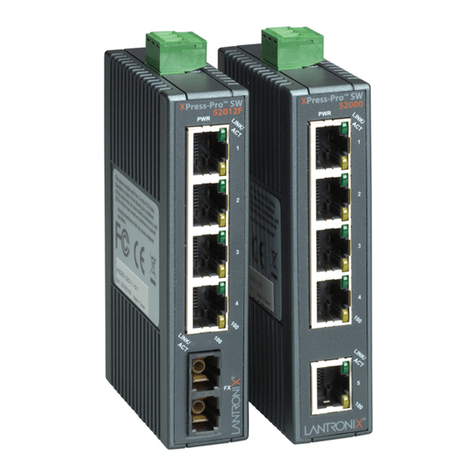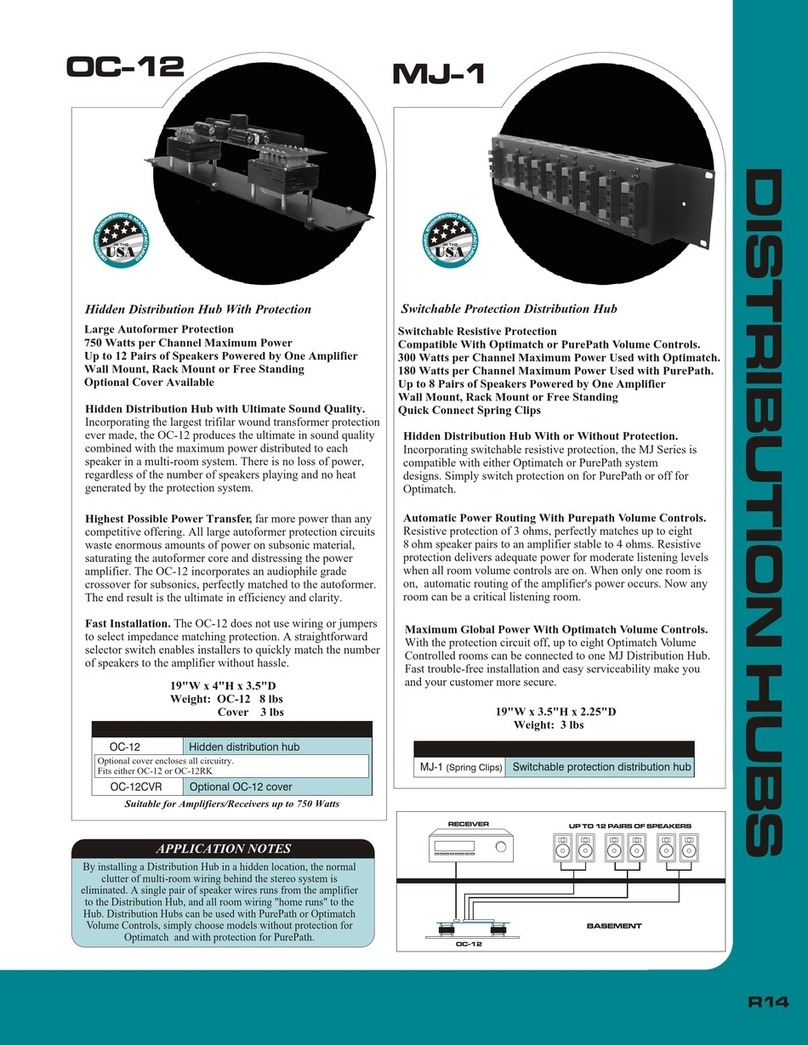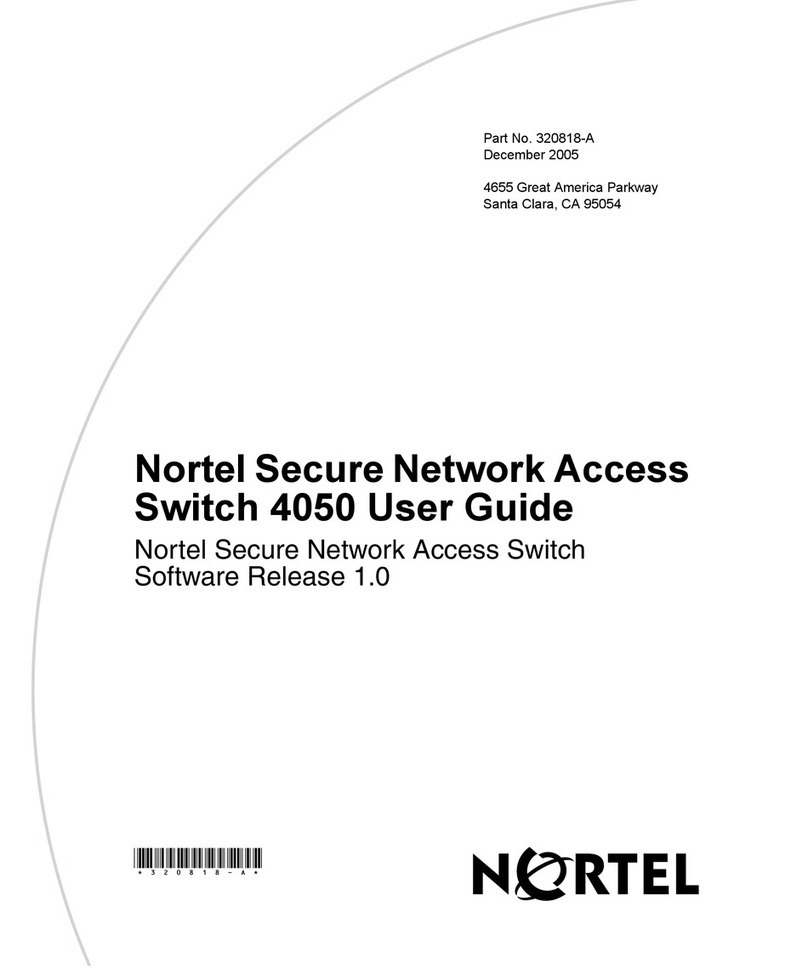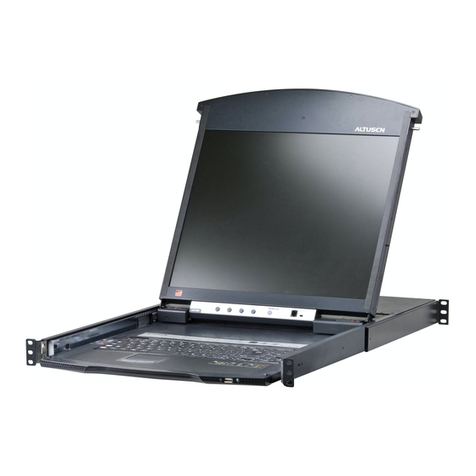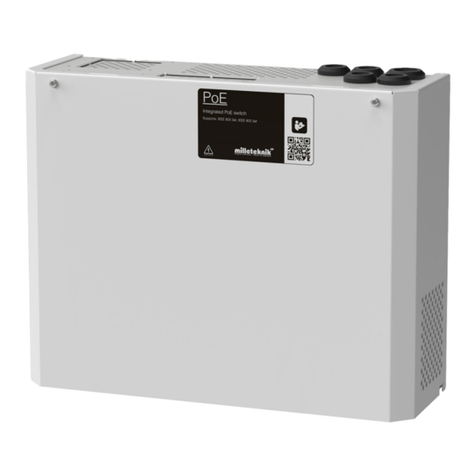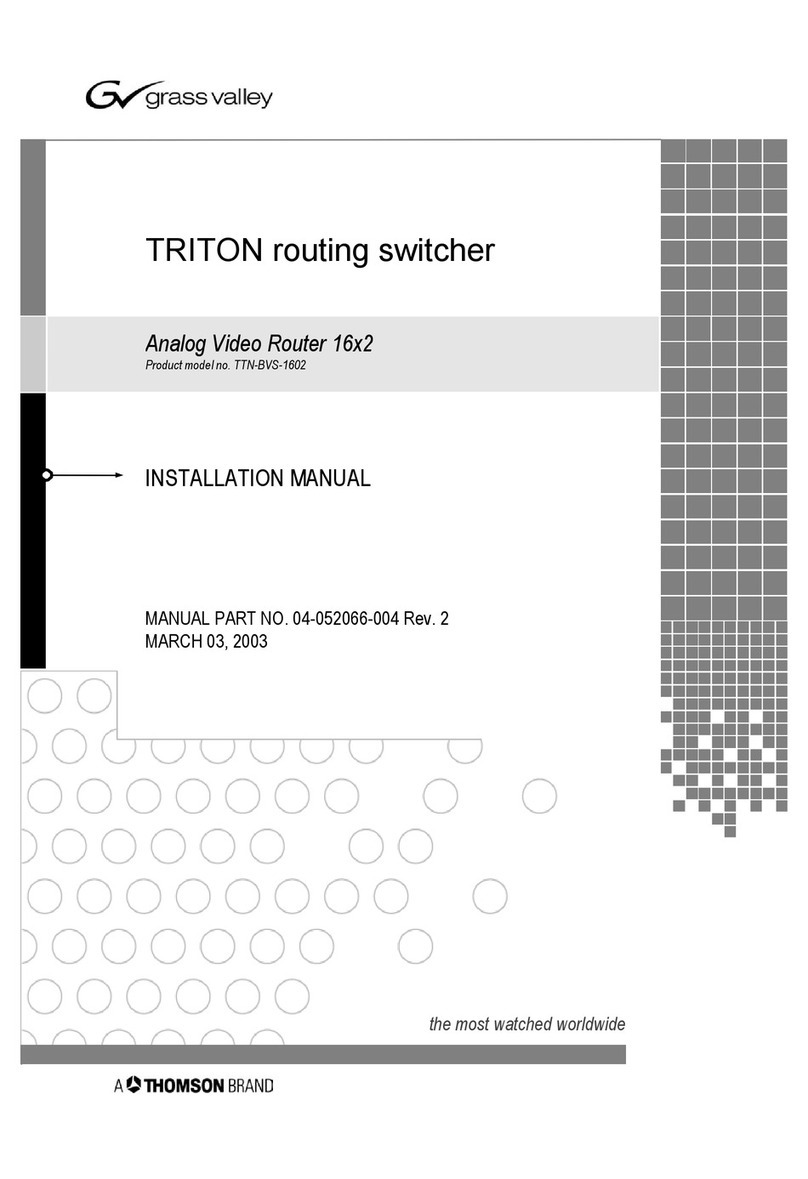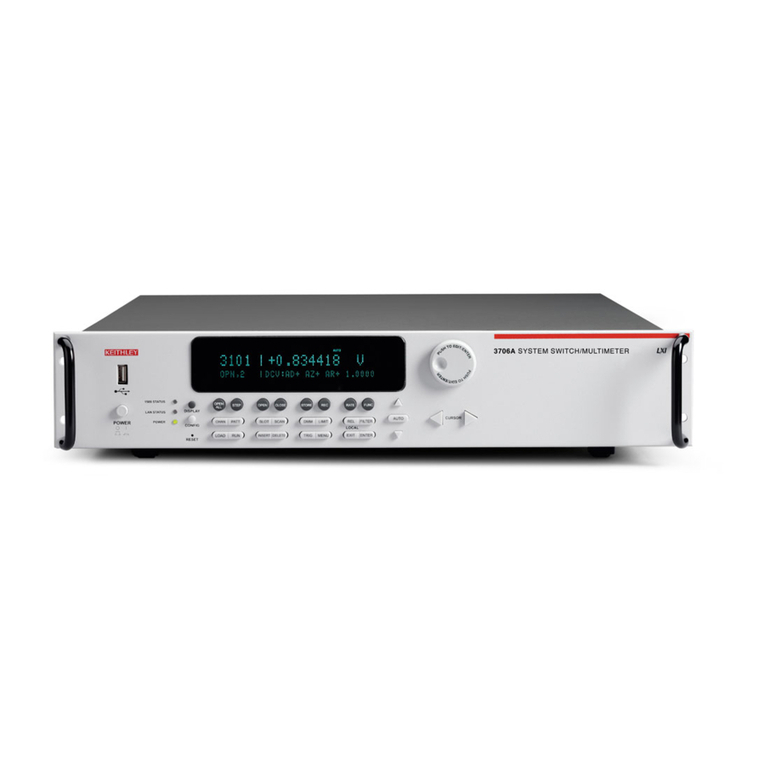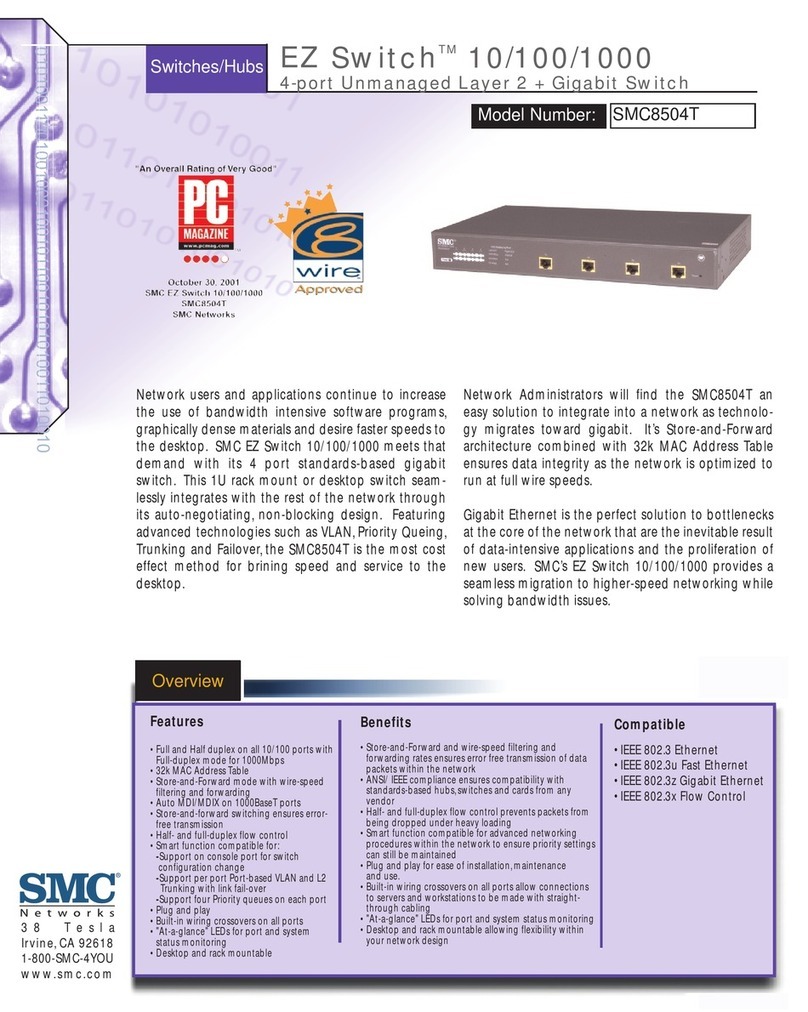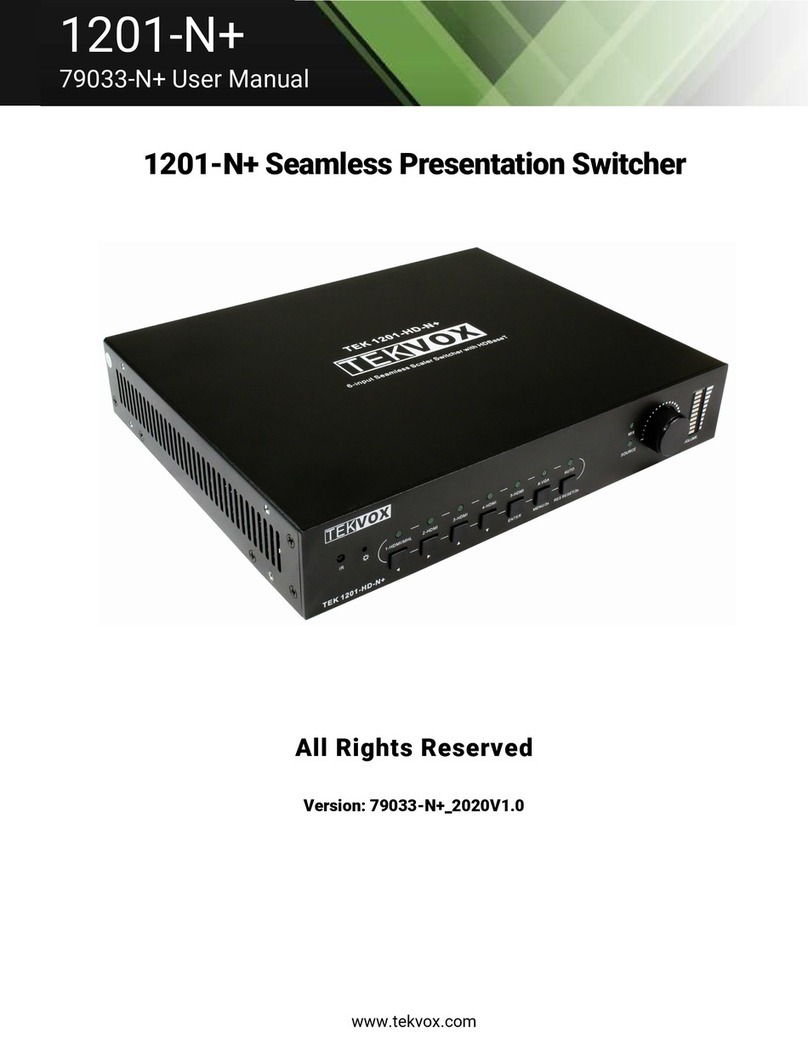PS Engineering PMA6000 User manual

9800 Martel Road
Lenoir City, TN 37772
www.ps-engineering.com
PMA6000 PMA6000M
PMA6000C PMA6000M-C
Audio Selector Panel with Intercom System
and
Marker Beacon Receiver
Installation and Operation Manual
Flying never sounded so good™
FAA-ApprovedTSO C35d
TSO C50c
Document P/N 200-066-0100
Revision 1, March 2005
PS Engineering, Inc. 2005 ©
Copyright Notice
Any reproduction or retransmittal of this publication, or any portion thereof, without the expressed written
permission of PS Engineering, Inc. is strictly prohibited. For further information contact the Publications
Manager at PS Engineering, Inc., 9800 Martel Road, Lenoir City, TN 37772. Phone (865) 988-9800

PS Engineering
PMA6000 Series Audio Selector Panel and Intercom System
Installation Manual
200-066-0100 Page ii Rev. 1, March 2005
Table of Contents
Section I GENERAL INFORMATION................................................................................................ 1-1
1.1 INTRODUCTION....................................................................................................................1-1
1.2 SCOPE ..................................................................................................................................... 1-1
1.3 EQUIPMENT DESCRIPTION................................................................................................ 1-1
1.4 APPROVAL BASIS - FAA..................................................................................................... 1-2
1.5 SPECIFICATIONS..................................................................................................................1-2
1.6 EQUIPMENT SUPPLIED....................................................................................................... 1-3
1.7 EQUIPMENT REQUIRED BUT NOT SUPPLIED................................................................ 1-4
1.8 LICENSE REQUIREMENTS.................................................................................................. 1-4
Section II -Installation.......................................................................................................................... 2-1
2.1 GENERAL INFORMATION .................................................................................................. 2-1
2.1.1 SCOPE................................................................................................................................. 2-1
2.2 Unpacking and Preliminary Inspection.................................................................................... 2-1
2.3 Equipment Installation Procedures........................................................................................... 2-1
2.3.1 Cooling Requirements......................................................................................................... 2-1
2.3.2 Mounting Requirements...................................................................................................... 2-2
2.3.3 Mounting Rack Installation................................................................................................. 2-2
2.3.4 Connector Assembly............................................................................................................ 2-2
2.4 Cable Harness Wiring .............................................................................................................. 2-2
2.4.1 Noise.................................................................................................................................... 2-2
2.4.2 Entertainment Input.............................................................................................................2-3
2.4.3 External Push-to-Talk.......................................................................................................... 2-3
2.4.4 Transmit Interlock ............................................................................................................... 2-4
2.4.5 Power................................................................................................................................... 2-4
2.4.6 Existing KMA-24 Installation............................................................................................. 2-4
2.4.7 "Swap" Mode....................................................................................................................... 2-4
2.4.8 Backlighting ........................................................................................................................ 2-4
2.4.9 Speaker Loads ..................................................................................................................... 2-5
2.4.10 PA Mute.......................................................................................................................... 2-5
2.4.11 Middle Marker Sense...................................................................................................... 2-5
2.4.12 Unswitched Inputs .......................................................................................................... 2-5
2.4.13 Intercom.......................................................................................................................... 2-5
2.4.14 Digital recorder (-IRS units only)................................................................................... 2-5
2.5 Adjustments.............................................................................................................................. 2-6
2.6 Marker Antenna Installation.....................................................................................................2-6
2.7 Communications Antenna Installation Notes........................................................................... 2-6
2.8 Unit Installation........................................................................................................................ 2-6
2.9 Post Installation Checkout........................................................................................................ 2-7
2.9.1 Required Test Equipment.................................................................................................... 2-7
2.9.2 Power Test........................................................................................................................... 2-7
2.9.3 Operational Checkout, 6000, 6000C, 6000M...................................................................... 2-7
2.10 Marker Checkout, 6000M, 6000M-C Only.............................................................................. 2-8
2.10.1 Operational Checkout, 3rd com version (6000C and 6000M-C)..................................... 2-8
2.11 Final Inspection........................................................................................................................ 2-8
Section III OPERATION.................................................................................................................... 3-1
3.1 SCOPE ..................................................................................................................................... 3-1
3.2 Audio Selector (All models).....................................................................................................3-1
3.2.1 Speaker Amplifier................................................................................................................ 3-1
3.3 Mic Selector Switch (Fail Safe Operation) .............................................................................. 3-1
3.3.1 MicSelectorSwitch,Com3(6000C,6000MC) .................................................................................. 3-2
3.3.2 Swap Mode (Switch from Com 1 to Com 2 remotely)........................................................ 3-2
3.4 Split Mode (6000, 6000M)....................................................................................................... 3-2

PS Engineering
PMA6000 Series Audio Selector Panel and Intercom System
Installation Manual
200-066-0100 Page iii Rev. 1, March 2005
3.5 Split Mode (6000C, 6000MC) ................................................................................................. 3-2
3.6 Intercom ................................................................................................................................... 3-3
3.6.1 Volume Control, Monaural (6000, 6000M, 6000C, 6000MC)............................................ 3-3
3.6.2 Adjusting the VOX-Squelch control, (6000, 6000M, 6000MC)......................................... 3-3
3.6.3 Intercom Modes................................................................................................................... 3-3
3.6.4 Push to talk intercom mode ................................................................................................. 3-4
3.6.5 Internal Recorder System (Option IRS, only) ..................................................................... 3-4
3.7 Marker Beacon (PMA6000M, PMA6000M-C)....................................................................... 3-5
3.7.1 Middle Marker Sense........................................................................................................... 3-5
3.7.2 External Marker Lights (6000M, 6000MC)........................................................................ 3-5
3.7.3 External Marker Audio Input (6000, 6000C)...................................................................... 3-5
3.7.4 Receiver Sensitivity............................................................................................................. 3-5
Section IV- Warranty and Service...................................................................................................... 4-1
4.1 Warranty................................................................................................................................... 4-1
4.2 Factory Service......................................................................................................................... 4-1
Appendix A External PTT Hook Up.....................................................................................................A
Appendix B- Installation Drawing.........................................................................................................B
Appendix D Top Connector wiring (Mono), PMA6000, PMA6000C, PMA6000M, PMA6000M-CD
Appendix F -Instructions for Continuing Airworthiness and FAA Form 337 ..................................E
Appendix G RTCA DO160B Environmental Qualification Form..................................................... F
Table of Figures
Figure 1-1 PMA6000M............................................................................................................................... 1-2
Figure 1-2 PMA6000M-C........................................................................................................................... 1-2
Figure 2-1 Adjustments............................................................................................................................... 2-6
Figure 3-1 Audio Selector........................................................................................................................... 3-1
Tables
Table 3-1 Intercom Modes.......................................................................................................................... 3-4
Revision History
Rev By Date Change
1 GLP March 2005 New release of PMA6000 Mono only manual, removing obsolete Stereo references

PS Engineering
PMA6000 Series Audio Selector Panel and Intercom System
Installation Manual
200-066-0100 Page 1-1 Rev. 1, March 2005
Section I
GENERAL INFORMATION
1.1 INTRODUCTION
The PMA6000 family of Audio Selector Panels are revolutionary products. Never before has there been so
much capability and utility in such a compact package. These units are designed for ease of use and instal-
lation, as well as to facilitate cockpit resource management and improve passenger entertainment.
Before installing and/or using this product, please read this manual completely. This will ensure that you
will take full advantage of all the advanced features.
1.2 SCOPE
This manual provides detailed installation and operation instructions for the PS Engineering PMA6000-
series of Audio Selector Panel/Intercom Systems. This includes the following units:
Model Description Part Number
PMA6000 Audio Selector Panel 6000
PMA6000M Audio Selector Panel with Marker Receiver 6000M
PMA6000C Audio Panel with Com 3 6000C
PMA6000M-C Audio Panel w/MKR and Com 3 6000MC
-IRS Digital Recorder added to any PMA6000 -IRS
Option 2 No silver trim around the bezel Opt. 2
Where the functions are identical to all units, it will be referred to herein as a PMA6000. Otherwise, the
applicable units will be specified.
1.3 EQUIPMENT DESCRIPTION
The PMA6000-series is a state of the art audio isolation amplifier and audio selector that contains a voice
activated (VOX) intercom system. It can switch up to three transceivers (Com 1, Com 2 and TEL) and six
receivers (Nav 1, Nav 2, ADF, DME, MKR and AUX). In addition, there are two unswitched inputs, for
telephone ringer and altimeter warning. Push buttons select the receiver audio source provided to the head-
phones. A SPR button allows the user to listen to the receiver(s) selected on the cabin speaker. Except for
the unswitched inputs, all speaker audio is muted during transmit. A rotary switch selects one of the three
transceivers for the pilot and copilot position in transmit. In "Split Mode" the PMA6000 has the ability to
allow the pilot and copilot to operate different transmitters independently and simultaneously.
A fail-safe mode connects the pilot headphone and microphone to COM 1 if power is removed for any
reason, or if the Mic Selector switch is turned to the Off position.
A six-station voice activated (VOX) intercom is included in the PMA6000. pilot isolate and crew modes,
two mono music inputs with "Soft Mute," and a 2-color Light Emitting Diode for power and transmit indi-
cations. Intercom control is through front panel mounted knobs. Monaural units have dual concentric
knobs that control pilot volume and intercom squelch, and copilot/passenger volume and squelch. In the
stereo versions, there is a single volume and squelch control for all on board.
An optional 3-light Marker Beacon receiver is integral to the PMA6000M and PMA6000MC. This pro-
vides the necessary Marker Beacon light and audio indications necessary for an Instrument Landing Sys-
tem (ILS) approach.

PS Engineering
PMA6000 Series Audio Selector Panel and Intercom System
Installation Manual
200-066-0100 Page 1-2 Rev. 1, March 2005
Figure 1-1 PMA6000M
Figure 1-2 PMA6000M-C
1.4 APPROVAL BASIS - FAA
TSO Approval.
The PMA6000, PMA6000C and Audio Selector Panels are FAA approved under TSO C50c (Audio Am-
plifiers).
The PMA6000M and PMA6000M-C are FAA approved under TSO C50c and TSO C35d (Marker Beacon
Receivers).
All systems comply with RTCA DO-143, DO-160b and DO-170.
Operation is subject to the following conditions:
1. This device may not cause harmful interference.
2. This device must accept any interference received, including interference that may cause undesired
operation.
1.5 SPECIFICATIONS
GENERAL SPECIFICATION CHARACTERISTIC TSO COMPLIANCE:
Marker Beacon: C35d, Class A
Audio Selector/Intercom: C50c, Class A
APPLICABLE DOCUMENTS: RTCA DO-160b, RTCA DO-170 and RTCA DO-143
ENVIRONMENTAL Qualifications: A1D1/CAMXXXXXXXBBBBAAX
Temperature Range: Operating: -20°C to +55°C Storage: -40°C to +85°C
Altitude: Up to 50,000 feet in an non-pressurized area of the cockpit.
DIMENSIONS: Height: 1.3 in. (3.3 cm) Width: 6.25 in. (16.9 cm) Depth: 6.8 in. (17.3 cm)
WEIGHT (With Rack & Connectors) : 1.5 Lb. (0.68 kg.)
POWER REQUIREMENTS (Including Internal Lighting):
Voltage: 13.75 or 27.5 VDC*
Maximum Current: 1 Amp (Externally protected by a 2 Amp circuit breaker.)
Typical operating current: speaker off: 350 mA
speaker on: 600 mA
Audio selector panel input impedance: 510 Ω
Input Isolation: -70 dB (min.)
Speaker Muting: -60 dB (min.)
Speaker Output (into 4 Ω): 3 Watts (min.) with no clipping
Switched Receiver Inputs: 8
(Com 1, Com 2, Nav 1, Nav 2, ADF, DME, MKR, AUX)

PS Engineering
PMA6000 Series Audio Selector Panel and Intercom System
Installation Manual
200-066-0100 Page 1-3 Rev. 1, March 2005
Unswitched Inputs: 2
(TEL Ringer, Altimeter DH)
Transmitter Selections: 5
(Com 1, Com 2, Com1/2, Com2/1, TEL/Com1)
on PMA6000, , PMA6000M
(Com 1, Com 2, Com1/2, Com2/1, Com 3)
on PMA6000C, PMA6000M-C
Speaker Impedance: 4 Ω
Headphone Impedance: 150 - 1000 Ω
Headphone Output: 45 mW each headset with no clipping
Microphone Impedance: 150 - 600 Ω
Intercom Positions: 6 places
Music Inputs: 2
Music Muting: >50 dB "Soft Mute" when Com or intercom active.
Distortion: <1% THD @ 45 mW into 150Ω
Mic Freq. Response, ±3 dB: 350 Hz - 6000 Hz
Music Freq. Response, ±3 dB: 200 Hz - 15 kHz
MARKER BEACON RECEIVER: (PMA6000M, PMA6000M-S, PMA6000M-C, PMA6000M-S-C
Only)
Frequency: 75 MHz Crystal Controlled
Sensitivity:
Low: 450 µVolts (Hard)
Factory adjusted to 1400µV (Soft)
High: 160 µVolts (Hard)
Factory adjusted to 150µV (Soft)
Selectivity: -6 dB at 110 kHz -40 dB at 120 kHz
External Lamp Output: 9.0 (+/- 0.5) VDC Positive when active, max. current 125 mA
MM Sense: Active high (4.7 VDC +/- 0.5V) during Middle Marker acqui-
sition, for autopilot use.
1.6 EQUIPMENT SUPPLIED
A. 1 ea. of the following units:
Model Part Number
PMA6000 6000
PMA6000M 6000M
PMA6000C 6000C
PMA6000M-C 6000MC
Tray 430-004-0001
B. PMA6000 Installation Kit:
Part Number Description Quantity
120-425-4401 Top Connector, (key 2/3) 1
120-425-4400 Bottom Connector (key 7/8) 1
425-001-0001 Gold Plated Crimp Pins 75
701-015-0015 15 Watt Dropping Resistor (Recommended for 28 Volt Systems) 1

PS Engineering
PMA6000 Series Audio Selector Panel and Intercom System
Installation Manual
200-066-0100 Page 1-4 Rev. 1, March 2005
1.7 EQUIPMENT REQUIRED BUT NOT SUPPLIED
A. Speaker, 4 Ω
B. Headphones, mono, up to 6 as required
C. Microphones, up to 6 as required
D. Marker Antenna (75 MHz, VSWR <1:1.5, and appropriate for the airspeed)
E. Interconnect Wiring
F. Headphone Jacks (Up to 6 as required)
G. Microphone Jacks (Up to 6 as required)
H. Circuit Breaker: 1 ea. 2 amp.
I. PMA6000 Installation Manual, P/N 200-066-0100, available at www.ps-engineering.com
1.8 LICENSE REQUIREMENTS
None

PS Engineering
PMA6000 Series Audio Selector Panel and Intercom System
Installation Manual
200-066-0100 Page 2-1 Rev. 1, March 2005
Section II -Installation
2.1 GENERAL INFORMATION
2.1.1 SCOPE
This section provides detailed installation and interconnect instructions for the PS Engineering PMA6000-
Series Audio Selector Panel/Intercom System and PMA6000M-Series Audio Selector Panel/Intercom Sys-
tem with internal Marker Beacon.
With the exception of the internal marker beacon receiver, the PMA6000, and PMA6000C are identical to
the PMA6000M, PMA6000M-C. All units will be identified hereafter as the PMA6000, where the infor-
mation applies to all.
Please read this manual carefully before beginning any installation to prevent damage and post installation
problems. Installation of this equipment requires special tools and knowledge. The equipment must be
installed by an appropriately rated Certified Aircraft Repair Station, in accordance with applicable regula-
tions.
NOTE: The PMA6000-Series requires specialized knowledge equipment and tools for an effective instal-
lation. An appropriately rated Certified Aircraft Repair Station must install this equipment in accordance
with applicable regulations. PS Engineering, Incorporated warranty is not valid unless the equipment is
installed by an authorized PS Engineering, Incorporated dealer. Failure to follow any of the installation
instructions, or installation by a non-certified individual or agency will void the warranty, and may result in
an unairworthy installation.
2.2 Unpacking and Preliminary Inspection
Use care when unpacking the equipment. Inspect the units and parts supplied for visible signs of shipping
damage. Examine the unit for loose or broken buttons, bent knobs, etc. Verify the correct quantity of com-
ponents supplied with the list in Section 1.6 (B). If any claim is to be made, save the shipping material and
contact the freight carrier. Do NOT return units damaged in shipping to PS Engineering. If the unit or ac-
cessories shows any sign of external shipping damage, contact PS Engineering to arrange for a replace-
ment. Under no circumstances attempt to install a damaged unit in an aircraft. Equipment returned to PS
Engineering for any other reason should be shipped in the original PS Engineering packaging, or other
UPS approved packaging.
2.3 Equipment Installation Procedures
2.3.1 Cooling Requirements
Forced-air cooling of the PMA6000 is not required. However the unit should be kept away from heat pro-
ducing sources (i.e. defrost or heater ducts, dropping resistors, heat producing avionics) without adequate
cooling air provided.
NOTICE: To reduce the amount of heat dissipated in the audio selector panel, when used in a 28
Volt aircraft, it is required that the 15 Ω, 15-Watt dropping resistor (p/n 701-015-1501) be in-
stalled in series with the power input.
If the PMA6000/M-S is installed in a 27.5 VDC aircraft system, a 15 Ω, 15 Watt dropping resistor (p/n
701-015-1501) should be installed. Failure to do so will generate unnecessary heat inside the unit and may
void PS Engineering's warranty.

PS Engineering
PMA6000 Series Audio Selector Panel and Intercom System
Installation Manual
200-066-0100 Page 2-2 Rev. 1, March 2005
2.3.2 Mounting Requirements
The PMA6000 must be rigidly mounted to the instrument panel of the aircraft structure and within view
and reach of the pilot position(s). Installation must comply with FAA Advisory Circular AC 43.13-2A. The
unit may be mounted in any area where adequate clearance for the unit and associated wiring bundle exist.
NOTE: The mounting hole configuration for the PMA6000 is identical to the KMA-24 Audio Se-
lector Panel. See Appendix B
2.3.3 Mounting Rack Installation
Remove the unit from the mounting tray by first removing the copilot volume and squelch knobs (the
knobs are press-fit on the shaft) and then unscrew the 3/32-inch hex-head screw that is to the right of the
copilot control knob shaft. Carefully slide the unit free of the tray. Set the unit aside in a safe location until
needed. Install the tray using six FHP 6-32 x ½-inch screws. The audio selector panel must be supported at
front and rear of the mounting tray.
2.3.4 Connector Assembly
The unit connectors mate directly with the circuit boards in the PMA6000. The connectors are a Molex
crimp-type, and require the use of a Molex hand crimp tool, EDP P/N 11-01-0203, CR6115B (or equiv.).
The connector is mounted to the unit tray with #4-40 screws, from the inside of the tray. Ensure that proper
strain relief and chafing precautions are made during wiring and installation.
2.4 Cable Harness Wiring
Referring to appropriate Appendix C, D, E and F, assemble a wiring harness as required for the installa-
tion. All wires must be MIL-SPEC in accordance with current regulations. Two- and three-conductor with
shield wire must be used where indicated, and be MIL-C-27500 or equivalent specification. Proper strip-
ping, shielding and soldering technique must be used at all times. It is imperative that correct wire be used.
Refer to FAA Advisory Circular 43.13-2A for more information. Failure to use correct techniques may
result in improper operation, electrical noise or unit failure. Damage caused by improper installation will
void the PS Engineering warranty.
2.4.1 Noise
Due to the variety and the high power of radio equipment often found in today's general aviation aircraft,
there is a potential for both radiated and conducted noise interference.
The PMA6000 power supply is specifically designed to reduce conducted electrical noise on the aircraft
power bus by at least 50dB. Although this is a large amount of attenuation, it may not eliminate all noise,
particularly if the amplitude of noise is very high. There must be at least 13.0 VDC present at the bottom
connector, pin 20, of the PMA6000 for the power supply to work in its designed regulation. Otherwise, it
cannot adequately attenuate power line noise. Shielding can reduce or prevent radiated noise (i.e., beacon,
electric gyros, switching power supplies, etc.) However, installation combinations can occur where inter-
ference is possible. The PMA6000s were designed in a RFI hardened chassis and have internal Electro-
magnetic Interference (EMI) filters on all inputs and outputs.
Ground loop noise occurs when there are two or more ground paths for the same signal (i.e., airframe and
ground return wire). Large cyclic loads such as strobes, inverters, etc., can inject noise signals onto the
airframe that are detected by the audio system. Follow the wiring diagram very carefully to help ensure a
minimum of ground loop potential. Use only Mil Spec shielded wires (MIL-C-275000, or better). Under no
circumstances combine a microphone and headphone wiring into the same shielded bundle. Always use a
2- or 3-conductor, shield wire as shown on the installation wiring diagram.

PS Engineering
PMA6000 Series Audio Selector Panel and Intercom System
Installation Manual
200-066-0100 Page 2-3 Rev. 1, March 2005
Radiated signals can be a factor when low level microphone signals are "bundled" with current carrying
power wires. Keep these cables physically separated. It is very important that you use insulated washers to
isolate the ground return path from the airframe to all headphone and microphone jacks.
Adding a high-performance audio control system, particularly in conjunction with active noise canceling
headsets, cannot improve on older avionics that were designed for cabin-speaker use. PS Engineering
makes no claim that the audio panel will provide a noise-free audio quality under all installation conditions,
particularly with older avionics.
2.4.2 Entertainment Input
Two entertainment devices (CD player, cassette player, etc.) can be connected to the unit. Install two 1/8-
inch jacks in a convenient location so that the pilot can plug in the entertainment devices into the system.
NOTE: Use the low level output of any entertainment device to connect to the
audio panel. Maximum signal level is 2 VAC p-p. DO NOT use a speaker-
level output, this will cause internal damage in the audio panel.
To use a line level, install an AudioLink PowerLink 101PL2 adapter, available
from Crutchfield at 1-800-955-3000
For a stereo input, we recommend tying the left and right channels (tip and ring) together, so both stereo
channels are provided to the monaural audio panel, and the audio amplitude available to the audio panel is
increased. Audio signal at the entertainment input must be a minimum of 500 mV P-P for optimum music
performance. We have noticed that the portable devices using 4 batteries seem to work better than the 2-
cell types. Also we have found that some cigarette-lighter adapters introduce noise into the system due to
the dropping power supply.
NOTE: The Soft Mute must be enabled in the 6000, 6000M, 6000C, 6000MC
either by connecting top connector pins N and 12 together in the harness, or
through an external Soft Mute Enable switch.
2.4.2.1 Soft Mute
The PMA6000-system incorporates a "Soft Mute" system. This will mute the entertainment devices during
ICS or radio traffic. While in the ALL or ISO modes, entertainment #1 is heard by everyone (except by the
pilot in ISO mode). While in the CREW mode, pilot and copilot will hear entertainment #1 while the pas-
sengers will hear entertainment #2.
Entertainment inputs #1 and #2 can be paralleled so a single entertainment source can serve both the
passengers and the crew in "crew" mode. It is suggested however, that a switch (DPDT) is installed
between the single entertainment device and entertainment input #1. This will allow the pilot and copilot to
decide if they hear entertainment while in the Crew mode.
Local oscillators and internal signals from some entertainment equipment can cause undesired interference
with other aircraft systems. Before takeoff, operate the entertainment devices to determine if there is any
adverse effect within the aircraft systems. If any unusual operation is noted in flight, immediately switch
off the entertainment devices.
2.4.3 External Push-to-Talk
An important part of the installation is the PTT (Push-To-Talk) switches that allow the use of your aircraft
communications radio for transmissions. There are three typical configurations that can be used. Select the
case that best fits the installation. Only the person who presses their PTT switch will be heard over the ra-
dio. If the pilot and copilot both use the PTT, the copilot position has access to the radio. The pilot posi-
tion will have PTT control regardless of the copilot when the PMA6000 is in the FAIL-SAFE mode.

PS Engineering
PMA6000 Series Audio Selector Panel and Intercom System
Installation Manual
200-066-0100 Page 2-4 Rev. 1, March 2005
CASE I: PTT is built into both pilot and copilot yokes.
CASE II: PTT is in pilot yoke only. This configuration requires a modified external PTT switch plugged
into the copilot's microphone jack. (See Appendix A). When the copilot's PTT is pressed, the intercom
switches the mic audio from pilot to copilot mic.
CASE III: No built in PTT. This requires two built in PTTs to be installed, or modified external PTT
switches to be used. Modify external PTT as required (See Appendix A).
2.4.4 Transmit Interlock
Some communications transceivers use a transmit interlock system. In order to fully utilize the Split Mode
feature, this function must be disabled. Consult that manufacturer's installation manual.
2.4.5 Power
The PMA6000-Series are compatible with both 13.8 and 28 Volt DC systems. A two (2) Amp circuit
breaker is required. Power and ground wires must be a twisted #18 AWG pair.
Included with this product is a power dropping resistor to be connected in series with the power input, bot-
tom connector, pin 20. This dropping resistor is supplied for 28 volt systems so that unnecessary heat dis-
sipation inside the PMA6000 can be avoided.
NOTICE: To reduce the amount of heat dissipated in the audio selector panel, when used in a 28
Volt aircraft, a 15 Ω, 15 Watt dropping resistor (p/n 701-015-1501) must be installed in series
with the power input.
2.4.6 Existing KMA-24 Installation
If the installation replaces a KMA-24 (series -01, -02 or -03), the existing 44 pin connector can be used for
the bottom connector of the PMA6000 tray as it is, if it is properly installed and wired. A dropping resistor
must be in series with the power in a 28V KMA 24 installation. No other changes are required except for
external marker lights (see Section 3.7.2 for details). The "key" in the existing connector must be located
between pins 7 and 8. This connector will be used in the bottom connector position. (See appropriate Ap-
pendix for complete wiring harness details.)
2.4.7 "Swap" Mode
When a normally-open, momentary, push-button switch is connected between pin 10 on the top connector
and aircraft ground, the user can switch between Com 1 and 2 by depressing this switch without having to
turn the mic selector switch. This yoke mounted switch eliminates the need of removing your hands from
the yoke to change transceivers.
NOTICE: Some older model radios may cause the Swap mode to activate on the release of the
PTT switch, due to the excessive back EMF from the collapsing relay coil field. Verify that back
EMF suppression, in the form of a diode across the T/R relay coil, is present if un-commanded
Swap occurs.
2.4.8 Backlighting
The PMA6000 has an automatic back-lighting system controlled by a photo detector. Additional control
can be gained by the aircraft avionics dimmer control. Connect the dimmer control line to bottom connec-
tor pin D for 14-volt systems, and to bottom connector pin F for 28-volt systems. Pin E is light ground.
This installation provides the ability to bring the backlighting level to zero. If dimmer control is not used, a
constant low-level back light illumination has been established for nighttime viewing. The photocell lo-
cated at the lower right hand side of the unit face will automatically adjust the backlight of the push-button
lamps as well as the rotary mic selector switch light intensity.

PS Engineering
PMA6000 Series Audio Selector Panel and Intercom System
Installation Manual
200-066-0100 Page 2-5 Rev. 1, March 2005
2.4.9 Speaker Loads
Certain VHF Nav/Comms, such as King KX170-series have internal speaker amplifiers. These are not used
with a PMA6000, but must be loaded to prevent unit failure. Connect the speaker output from the
Nav/Com to the appropriate load on the PMA6000 (bottom connector 19 and L for COM 1, etc).
2.4.10 PA Mute
Bottom connector pin 18 is a TTL logic output that is pulled low during PTT operation. This serves as an
input to external public address system to prevent feedback during transmissions.
2.4.11 Middle Marker Sense
The MM Sense output is connected to certain specific autopilots, and goes high only when a middle marker
signal is received, not in test.
2.4.12 Unswitched Inputs
The PMA6000 has two unswitched inputs. Bottom connector pin 17 is unswitched, but muted by transmis-
sions. This signal can be used for less critical inputs such as airborne telephone ringer.
Bottom connector pin T is an unswitched and unmuted audio input. This audio is always presented to the
headphones and speaker, regardless of the audio panel audio selections. This input can be use for critical
warnings, such as radio altimeter warnings.
2.4.13 Intercom
The top connector is for the intercom function. All mic and headphone jacks must have insulating washers,
the cable must be Teflon coated, twisted-shielded wire, and the shield must only be connected to the
ground return wire only at the intercom connector. NOTE: This harness can be custom made by PS Engi-
neering, Inc. Simply call the factory and obtain a wire harness work sheet. The harness will be made to
your specifications and fully functionally tested. All hardware is included. (See Appendix C for intercom
connection diagrams).
2.4.13.1 Push-to-talk intercom
PMA6000-series units with intercom board (second series of numbers on data plate) serial number above a
“G” series in stereo, or “MO series in mono, include a push-to-talk intercom capability.
In some extremely high noise environments, it may be desirable to have a push to talk (PTT) intercom,
instead of relying on voice-activation (VOX).
To operate the PTT, simply rotate the PMA6000 squelch control to maximum (fully CW). Grounding the
appropriate pin on the top connector through a momentary switch will open only that intercom channel.
The pilot and copilot are individually controlled (Top connector, pins 22 and 21, respectively). All passen-
ger mics are controlled with pin 20.
This applies ONLY to units with applicable serial numbers. If a unit with serial number below that indi-
cated is installed in a position wired for the PTT, no damage will occur, only the ICS PTT function will not
function.
2.4.14 Digital recorder (-IRS units only)
If the PMA6000-series unit is identified with Option 1, there is an internal recorder built into the unit. This
stores the last 60 seconds of radio traffic from the selected Com transceiver (the one selected for transmit).
To use this function, a normally-open momentary switch is installed between the top connector Pin 19 and
aircraft ground. A low-current switch is recommended.

PS Engineering
PMA6000 Series Audio Selector Panel and Intercom System
Installation Manual
200-066-0100 Page 2-6 Rev. 1, March 2005
A radio signal of more than 1 VRMS is needed to trigger the IRS. Therefore, if the IRS does not seem to be
recording, increase the aircraft radio volume slightly.
2.5 Adjustments
The PMA6000 is factory adjusted to accommodate the typical requirements for most aircraft configura-
tions. There are three adjustments however, that will allow the installer to tailor the specific functions. The
numbers correspond to identification numbers stamped on some trays.
Adjustment Clockwise Results In
Cabin Speaker Level Increase Speaker Vol-
ume
Marker Beacon Level Decrease Marker Volume
MKR Gain Increase overall sensitiv-
ity
MKR High Sense Increase sensitivity
MKR Low Sense Increase Sensitivity
Pass. Headphone (Mono ) Louder
To make the necessary adjustments, use a small
jeweler's slotted screwdriver.
Figure 2-1 Adjustments
2.6 Marker Antenna Installation
Refer to aircraft and antenna manufacturer's installation instructions, as well as AC43.13-2A (or later revi-
sion), Chapter 3, for information on proper antenna installation techniques. The marker beacon antenna
must be mounted on the bottom of the aircraft.
2.7 Communications Antenna Installation Notes
For best results while in Split Mode, it is suggested that the one VHF communications antenna be located
on top of the aircraft while the other communications antenna be on the bottom. Any antenna relocation
must be accomplished in accordance with AC 43.13-2A, aircraft manufacturers’ recommendations and
FAA-approved technical data.
Warning: It is probable that radio interference will occur in the split mode when the frequencies
of the two aircraft radios are adjacent, and/or the antennas are physically close together. PS Engi-
neering makes no expressed or implied warranties regarding the suitability of the PMA6000 in
Split Mode.
2.8 Unit Installation
To install the PMA6000, remove the copilot volume and squelch knob. Gently slide the unit into the
mounting rack until the hold-down screw is engaged. While applying gentle pressure to the face of the unit,
tighten the 3/32" hex-head screw next to the copilot control shaft until the unit is secure. DO NOT OVER
TIGHTEN. Reinstall the knobs.
MKR Hi Sense
(
211
)
MKR Audio Level
(233
)
MKR Lo Sense
(231)
MKR Gain
(223)
Cabin Speaker
Level (111)
Pass
Volume
Level

PS Engineering
PMA6000 Series Audio Selector Panel and Intercom System
Installation Manual
200-066-0100 Page 2-7 Rev. 1, March 2005
Warning: Do not over-tighten the lock down screw while installing the unit in
tray.
Internal damage will result.
2.9 Post Installation Checkout
2.9.1 Required Test Equipment
In order to return an aircraft to service after installation of the PMA6000-series with marker beacon re-
ceiver, the installer must have access to a Marker Beacon signal generator:
a. IFR NAV401L, NAV402AP, IFR4000
b. TIC T-30D, T-36C
Equivalent test equipment is acceptable as long as the testing requirements can be met.
2.9.2 Power Test
After wiring is complete, verify power is ONLY on pin 20 of the bottom connector, and airframe ground
on bottom connector pin Z. Failure to do so will cause serious internal damage and void PS Engineering's
warranty.
2.9.3 Operational Checkout, 6000, 6000C, 6000M
1. Apply power to the aircraft and avionics.
2. Plug headsets into the pilot, copilot and passenger positions.
3. With avionics on, and the audio panel off, verify that the pilot can transmit and receive on COM 1,
through the headset, indicating proper “fail-safe” operation.
4. Rotate the Mic Selector Switch to the Com 1 position.
5. Verify that the C1 light comes on. Verify that the power LED (Light Emitting Diode) in the intercom
section illuminates green. If the LED is red, stop testing and troubleshoot the microphone PTT instal-
lation.
6. Verify proper transmit and receive operation on the copilot position, noting that the copilot PTT
switch allows proper transmission on the selected transceiver.
7. Verify that pushing the C2 button causes the button to illuminate, and the Com 2 receiver to be heard.
Verify operation on Com 1 from the pilot position.
8. Repeat for Com 2 and TEL, (if installed).
9. Rotate the mic selector switch to the COM 1/2 position. Verify that the pilot communicates on Com 1
and the copilot on Com 2.
10. Rotate the mic selector switch to the COM 2/1 position. Verify that the pilot communicates on Com 2
and the copilot on Com 1.
11. If PMA6000C or PMA6000MC. Go to section 2.10.1 Otherwise, rotate the mic selector switch to the
TEL/COM 1 position. Verify that the pilot communicates on the transceiver in the TEL position and the
copilot on Com 1.
12. Verify proper operation of all receiver sources by selecting them using the keypad. Note that the but-
ton for the receiver sources stays in, and the button illuminates to show which source is in use.
13. Push in the S (SPR) button. Verify that all selected audio is heard in the cockpit speaker. Verify that
the audio mutes when the mic is keyed.
14. Verify that the LED in the intercom changes from green to red when a microphone is keyed. NOTE:
LED does not change color in "Split Mode".
15. Verify proper Intercom system operation in the ALL, ISO And CREW modes.
16. Verify that the audio selector panel system does not adversely affect any other aircraft system by sys-
tematically switching the unit on and off, while monitoring the other avionics and electrical equipment
on the aircraft.

PS Engineering
PMA6000 Series Audio Selector Panel and Intercom System
Installation Manual
200-066-0100 Page 2-8 Rev. 1, March 2005
2.9.4 Operational Checkout, 3rd Com version (6000C and 6000M-C)
1. Complete steps 1 to 10, above.
2. Rotate the mic selector switch to the COM 3 position. Verify that the pilot communicates on the trans-
ceiver in the Com3 position and the copilot on Com 1.
3. Verify proper operation of all receiver sources by selecting them using the keypad. Note that the but-
ton for the receiver sources stays in, and the button illuminates to show which source is in use.
4. Push in the S (SPR) button. Verify that all selected audio is heard in the cockpit speaker. Verify that
the audio mutes when the mic is keyed.
5. Verify that the LED in the intercom changes from green to red when a microphone is keyed. NOTE:
LED does not change color in "Split Mode".
6. Verify proper Intercom System operation in the ALL, ISO and CREW modes.
7. Verify that the unit under test does not adversely affect any other aircraft system by systematically
switching the unit on and off, while monitoring the other avionics and electrical equipment on the air-
craft.
2.10 Marker Checkout, 6000M, 6000M-C Only
1. Connect a ramp generator at the antenna end of the marker coax. With the unit under test in HI sensi-
tivity, verify that a 150 µVolts, modulated 95% with 1300 Hz signal will illuminate the amber (M)
marker light, and that marker audio is present in the headphones when the Marker Audio (M) push-
button has been depressed. Select "S" for speaker to verify marker audio availability on the cabin
speaker. Verify that the white (A) and blue (O) lights will illuminate within ±3dB of the amber lamp,
with 3000 HZ and 400 Hz applied, respectively.
2. Repeat with the unit in LOW sensitivity, with 1400 µVolts applied.
3. Connect the marker antenna and verify proper operation.
2.11 Final Inspection.
Verify that the wiring is bundled away from all controls and no part of the installation interferes with air-
craft control operation. Move all controls through their full range while examining the installation to see
that no mechanical interference exists. Verify that the cables are secured to the aircraft structure in accor-
dance with good practices, with adequate strain relief. Ensure that there are no kinks or sharp bends in the
cables and coaxial cables. Verify that the cables are not exposed to any sharp edges or rough surfaces, and
that all contact points are protected from abrasion. Complete log book entry, FAA Form 337, weight and
balance computation and other documentation as required. Return completed warranty registration applica-
tion to PS Engineering, or register online at www.ps-engineering.com/warranty.shtml .

PS Engineering
PMA6000 Series Audio Selector Panel and Intercom System
Installation Manual
200-066-0100 Page 3-1 Rev. 1, March 2005
Section III OPERATION
GENERAL INFORMATION
3.1 SCOPE
This section provides detailed operating instructions for the PS Engineering PMA6000, PMA6000M,
PMA6000C, and PMA6000M-C Audio Selector Panel/Intercom Systems. Please read it carefully before
using the equipment so that you can take full advantage of its capabilities.
This section is divided into four sections covering the basic operating areas of the PMA6000 systems. They
are: Audio Selector, Transceiver Selection, Intercom, and Marker Beacon Receiver (6000M, 6000M-C
6000M-S and 6000M-S-C only).
3.2 Audio Selector (All models)
Through the use of two momentary and seven latched, push-button,
backlit switches, it is possible to select any or all receiver audio. C1
and C2 are momentary switches.
When selected, an internal backlight will illuminate indicating which
audio source is selected. Because the rotary switch controls what
transceiver is being heard by the pilot and copilot (the crew), "Cl"
(Com 1) and "C2" (Com 2) push-buttons are of the momentary type
and do not remain in when selected. This is also part of the "auto
function." You will always hear the audio from the transceiver that
is selected by the rotary mic selector switch.
The users can identify which receivers are selected by noting which
push-button switches are illuminated. Push buttons labeled Nl (Nav 1), N2 (Nav 2), D(DME), M
(Marker), A(ADF), AX (auxiliary), and S(Speaker) are "latched" type switches. When one of these but-
tons is pressed, it will stay in the "in" position. Press the switch again and it be in the "out" position and
remove that receiver from the audio. While selected, the switch will also be annunciated by an internal
lamp.
NOTE: In Split Mode, no pushbuttons will be active. The only audio selected is the com 1 and two, as in-
dicated by their respective lamps.
3.2.1 Speaker Amplifier
The "S" in the push-button section stands for speaker. This switch will place all selected audio on the cock-
pit speaker when this switch is selected. NOTE: with the exception of unswitched unmuted inputs
(Altimeter warning), the speaker amplifier is not active in the "Split Mode." To reduce power consumption
and internal heat buildup in the avionics stack, switch off the speaker amplifier when not in use.
3.3 Mic Selector Switch (Fail Safe Operation)
Unit power is turned on and off by the Mic selector switch. In the OFF or "FAIL-
SAFE" position, the pilot is connected directly to Com 1 allowing transmit and
receive capability regardless of unit condition. Any time power is removed or
turned OFF, the audio selector will be placed in the fail-safe mode. The first po-
sition clockwise from OFF is COM 1. Both pilot and copilot will be connected to
the Com l transceiver. While in the COM 1 or COM 2 mode, the intercom functions
normally. Both the pilot and copilot have transmit capabilities on the selected
transceiver. All hear the selected audio if the intercom is in the ALL mode. Only
Figure 3-1 Audio Selector
Figure 3-2 Micro-
phone Selector

PS Engineering
PMA6000 Series Audio Selector Panel and Intercom System
Installation Manual
200-066-0100 Page 3-2 Rev. 1, March 2005
the person who presses their Push To Talk (PTT), will be heard over the aircraft radio. Turning the rotary
switch to the COM 2 position will place pilot and copilot on Com 2.
The PMA6000-Series has an automatic selector mode. Audio from the selected transceiver is automatically
heard in the headsets and speaker (when selected). You can check this function by switching from COM 1
to COM 2 and watch the selected audio light on the selector change from C1 to C2. This ensures the pilot
will never transmit on a radio is is not listening to.
In PMA6000-series units, Serial Number T03092 and above, when switching the mic selector rotary
switch from COM 1 to COM 2, while COM 2 audio had been selected, Com 1 audio will continue to be
heard. This eliminates the pilot having to switch Com 1 audio back on, if desired.
When switching from COM 1 to COM 2 while Com 2 has NOT been selected, Com 1 audio will be switched
off. In essence, switching the mic selector will not effect the selection of Com audio.
Important: When the mic selector is in the full counter clockwise position, the PMA6000 power is re-
moved, and it is in the FAIL-SAFE mode. The pilot headset and microphone is connected directly to Com 1.
3.3.1 MicSelectorSwitch,Com3(6000C,6000MC)
In units designed to accommodate a third communications transceiver, placing the mic selector switch in
the COM 3 position connects the pilot and copilot to that radio. This is similar to COM 1 and COM 2, except
that the swap mode is not active.
3.3.2 Swap Mode (Switch from Com 1 to Com 2 remotely)
With a yoke mounted, momentary switch, the pilot can change from the current Com transceiver to the
other by depressing this switch. When "Swap Mode" is active, an LED annunciator will illuminate, indicat-
ing that the Mic Selector switch position is no longer valid. To cancel "Swap Mode," the pilot may either
press the yoke mounted switch again, or turn the Mic Selector Switch to the Com that is active.
3.4 Split Mode (6000, 6000M)
Turning the rotary switch to COM 1/COM 2 places the PMA6000 into "Split Mode". This places the pilot on
Com 1 and the copilot on Com 2. Pilot and copilot are isolated from each other on the intercom, but can
use their respective radios simultaneously. An example of this useful feature is when the pilot may want to
talk to Air Traffic Control, while the copilot may be speaking to Flight Watch.
The "Split Mode" radio selection can be reversed by switching to COM 2/COM l. The pilot will be on Com 2
and the copilot will be on Com 1. A third "Split Mode" selection is TEL/COM l. This will place the pilot on
airborne radiotelephone, HF or other transceiver (if installed), while the copilot will be on Com 1.
3.5 Split Mode (6000C, 6000MC)
Operation is identical to section 3.4 (above) except turning the mic selector clockwise to the COM 3 posi-
tion places both pilot and copilot on Com 3, and exits the split mode. All selected audio inputs and inter-
com function return.
Note: In all PMA6000s, Split Mode turns off all other (Nav, ADF, etc.) selected audio to pilot and
copilot. Additionally, there is no intercom function between pilot and copilot. Passengers still have
intercom capability among themselves.

PS Engineering
PMA6000 Series Audio Selector Panel and Intercom System
Installation Manual
200-066-0100 Page 3-3 Rev. 1, March 2005
3.6 Intercom
3.6.1 Volume Control (6000, 6000M, 6000C, 6000MC)
The pilot volume control knob adjusts the loudness of intercom
and music in the pilot’s headphones only. It has no effect on
selected radio audio levels. The copilot volume control adjusts
the loudness of the intercom and music in the copilot headset
only. The passenger volume is factory set at a comfortable level.
This is a service adjustment that can be accessed by the avionics
technician. Most general aviation headsets have a built-in
volume control, so volume can be adjusted “locally.”
3.6.2 Adjusting the VOX-Squelch control, (6000, 6000M, 6000MC)
The PMA6000 provides adjustable VOX squelch controls for the pilot and copilot (the copilot's VOX con-
trol also adjusts the passengers VOX squelch). Since the number of microphones open at any one time is
reduced, the amount of background noise is diminished. This also allows the use of dissimilar headsets
with the same intercom. The user can adjust the trip level of the VOX to fit the individual's voice and mic,
which helps eliminate the frustration of clipping the first syllables.
With the engine running, set the VOX control knob by slowly rotating the SQL control knob clockwise
until you no longer hear the engine noise in the headphones. When the microphone is positioned properly
near your lips, normal speech levels should open the channel. When you have stopped talking, there is a
delay of about ½ second before the channel closes. This helps prevent choppy communications.
3.6.3 Intercom Modes
The center switch is a 3-position mode switch that allows the pilot to tailor the intercom function to best
meet the situation. The description of the intercom mode function is valid only when the unit is either in
the COM 1 or COM 2 position of the Mic Selector switch. When the unit is in the "Split" mode, only the
passengers have intercom function.
ISO:(Up Position): The pilot is isolated from the intercom and is connected only to the aircraft radio. He
will hear the aircraft radio reception (and sidetone during radio transmissions). Copilot and passengers will
hear the intercom and music on Entertainment 1, but not the aircraft radio receptions or pilot transmissions.
ALL:(Middle Position): All parties will hear the aircraft radio, intercom, and music from entertainment
input #1. However, during any intercom communications, the music volume automatically decreases when
SoftMute is active (See section 3.6.5.1). The music volume increases gradually back to the original level
after communications have been completed.
CREW (Down Position): Pilot and copilot are connected on one intercom channel and have exclusive ac-
cess to the aircraft radios. They may also listen to Entertainment 1. Passengers can continue to communi-
cate with themselves without interrupting the Crew and also may listen to Entertainment 2. Anytime the
PMA6000 is in either the COM 1/COM 2, COM 2/COM 1, or TEL/COM 1, ("Split Mode") the pilot and copilot
do not have any intercom function. The passengers will maintain intercommunications.
3.6.3.1 Soft Mute
Soft Mute must be enabled during installation by connecting top connector pins 12 and N. A SPST switch
can be installed between these pins for a pilot selectable mute mode. Without this connection, music is not
muted during intercom activation. This “Karaoke Mode” prevents the music muting when a sing-along is
desired. "Soft Mute" mode only applies to entertainment input #1. Entertainment #2 does not mute.
Figure 3-3 Volume Controls

PS Engineering
PMA6000 Series Audio Selector Panel and Intercom System
Installation Manual
200-066-0100 Page 3-4 Rev. 1, March 2005
3.6.3.2 Entertainment Input
The audio selector panel has provisions for up to two separate entertainment input devices. Which device is
heard is determined by the position of the three position mode switch located in the center of the intercom
section of the audio panel. (See Table 3-1 for overview.)
While in the ISO (Isolate) mode, only the copilot and the four passengers will hear entertainment device
#1. In normal operation, whenever a person speaks or if the aircraft radio becomes active, the music will
automatically mute and then will gradually return to the original listening level when the intercom or radio
activity ceases.
Which entertainment device will be heard is determined by the mode selector switch. When in the ALL
mode, all parties will hear the entertainment input #1. While in the CREW mode, pilot and copilot will hear
entertainment input #1 while the passengers may listen to entertainment input #2.
It is also possible to use only one entertainment input device for both entertainment inputs. It is suggested
however, that a switch (DPDT) be installed between the single entertainment device and entertainment
input #1. This will allow the pilot and copilot decide if they hear entertainment while in the Crew mode.
Table 3-1 Intercom Modes
Mode Pilot Hears Copilot Hears Passenger Hears Comments
Isolate A/C Radio
Pilot Sidetone
(during radio transmis-
sion)
Copilot and passenger
intercom
Entertainment #1
Passenger and Copilot
intercom
Entertainment #1
This mode allows the
pilot to communicate with
the ground without the
copilot or passengers
bothered by the conver-
sations. Copilot and
passengers can continue
to communicate and
listen to music
All Pilot
Copilot
A/C Radio
Passengers
Entertainment #1
Copilot
Pilot
A/C Radio
Passengers
Entertainment #1
Passengers
Pilot
Copilot
A/C Radio
Entertainment #1
This mode allows all on
board to hear radio re-
ception as well as com-
municate on the inter-
com. Music and intercom
is muted during intercom
and radio communica-
tions
Crew Pilot
Copilot
A/C Radio
Entertainment #1
Copilot
Pilot
A/C Radio
Entertainment #1
Passengers
Entertainment #2 A second music source
is automatically enabled
for the passengers.
3.6.4 Push to talk intercom mode
PMA6000-series audio selector/intercom systems with serial number beginning with the letter “M” (mon-
aural version) or “G” (stereo version).
In some extremely high noise environments, it may be desirable to have a push to talk (PTT) intercom,
instead of relying on voice-activation (VOX).
In PMA6000 series with later configuration boards, the PTT intercom capability is added. To operate the
PTT, simply rotate the PMA6000 squelch control to maximum (fully CW). Grounding the appropriate pin
on the top connector through a momentary switch will open only that intercom channel. The pilot and copi-
lot are individually. All passenger mics are controlled with pin 20.
The same pins are used for both mono and stereo PMA6000 Systems. This applies ONLY to units with
applicable serial numbers.
3.6.5 Internal Recorder System (Option IRS, only)
Beginning in mid 1999, PS Engineering has an available internal recorder option. This stores the last 60
seconds of radio traffic from the selected Comm transceiver (the one selected for transmit).

PS Engineering
PMA6000 Series Audio Selector Panel and Intercom System
Installation Manual
200-066-0100 Page 3-5 Rev. 1, March 2005
The recorder function is automatic. Pressing the momentary switch will cause the last message to play (in-
coming radio and transmit sidetone). This will be heard in the pilot headset only. To hear older messages,
push the playback button repeatedly to “back up” the recorder, until the desired message is heard.
The recorder is a continuous loop, and newest ones will overwrite the oldest messages.
The IRS has an internal squelch that prevents storing ‘dead’ air. A radio signal of more than 1 VRMS is
needed to trigger the IRS. Therefore, if the IRS does not seem to be recording, increase the aircraft radio
volume slightly.
3.7 Marker Beacon (PMA6000M, PMA6000M-C)
The optional Marker Beacon Receiver uses visual and audio indicators to alert you
when the aircraft passes over a 75 MHz transmitter.
The Blue lamp, labeled "O," is the Outer Marker lamp and has an associated 400-Hertz
'dash' tone. The lamp and tone will be keyed at a rate of two tones/flashes per second
when the aircraft is in the range of the Outer Marker Beacon.
The Amber lamp, labeled "M," is the Middle Marker lamp and is coupled with a 1300-
Hertz tone. It is keyed alternately with short 'dot' and long 'dash' bursts at 95 combina-
tions per minute.
The White lamp, labeled "I," is the Inner marker/Airway and has a 3000-Hertz 'dot'
tone. The lamp and tone will be keyed at a rate of six times per second.
The audio from the Marker Beacon Receiver can be heard by selecting the "M" push-button switch. To
adjust the volume level, there is a service adjustment located on the top of the unit. See Section 2.5
A 3-position switch is used to set the receiver sensitivity and to test the indicator lamps. Use "HIGH" sensi-
tivity initially. This allows you to hear the outer marker beacon about a mile out. Then select the “LOW”
sensitivity to give you a more accurate location of the Outer Marker. The momentary down switch position
is labeled "TEST" and illuminates all three lamps simultaneously to assure the lamps are in working order.
Upon first application of power to the unit, the Marker enters a self test mode. The flickering blue marker
light indicates a test in process. If the test continues for more than 10 seconds, or the lamps do not extin-
guish, return the unit for service.
3.7.1 Middle Marker Sense
A Middle Marker sense output signal is available to automatically reduce the autopilot sensitivity after the
aircraft has passed over the Middle Marker. This function will not operate during the test mode. This out-
put will go to +4.75 VDC (±0.25 VDC) when a valid Middle Marker signal is received.
3.7.2 External Marker Lights (6000M, 6000MC)
For installations that require external marker beacon lights, there are three outputs that can drive 12 Volt
lamps only. The external output lamps are driven high (+9 VDC ±0.5 VDC) when active. Maximum
source current per lamp is 125 mA.
3.7.3 External Marker Audio Input (6000, 6000C)
If using an external marker receiver, the audio input is lower connector, pin 11 (Aux. input). This will ap-
pear at the audio when the M button is pressed.
3.7.4 Receiver Sensitivity
Although the PMA6000M meets FAA TSO-C35d sensitivity specifications, the sensitivity of the receiver
has been adjusted to meet real world requirements (150µV and 1400µV Soft). This will usually eliminate
Figure 3-4
Marker Beacon
Other manuals for PMA6000
2
This manual suits for next models
16
Table of contents
Other PS Engineering Switch manuals
